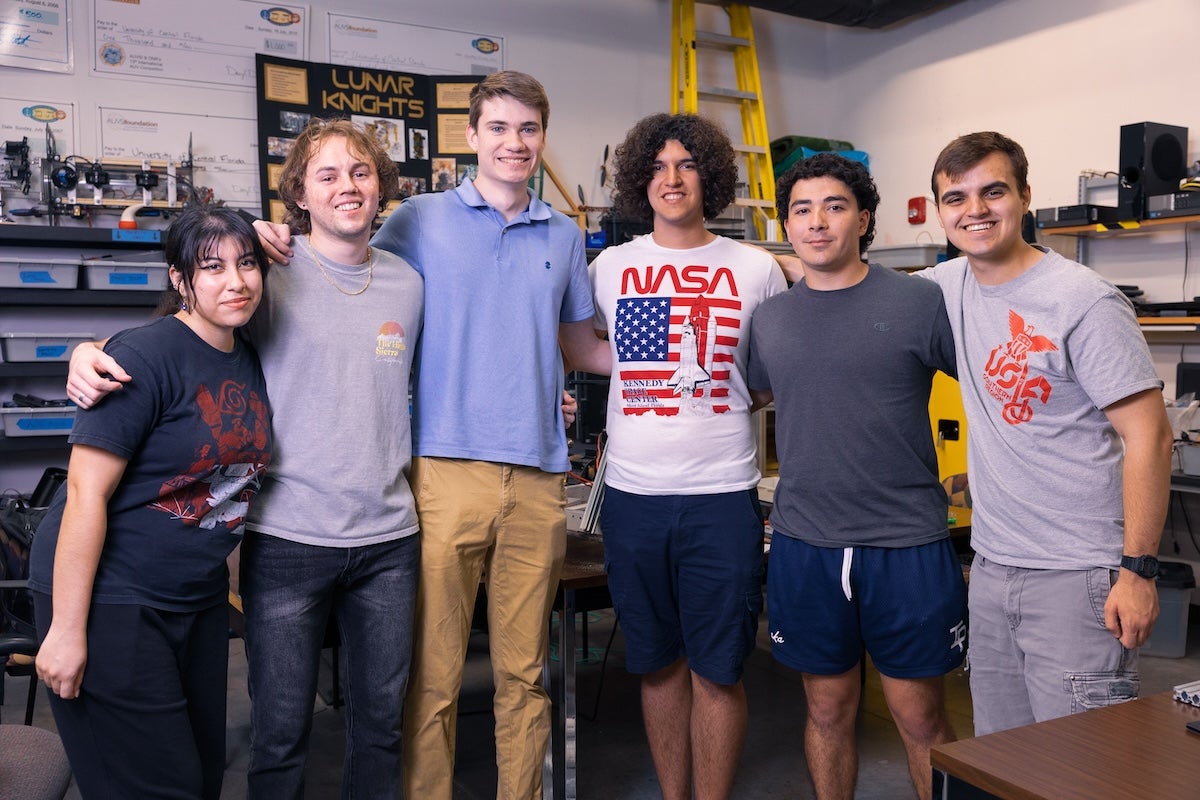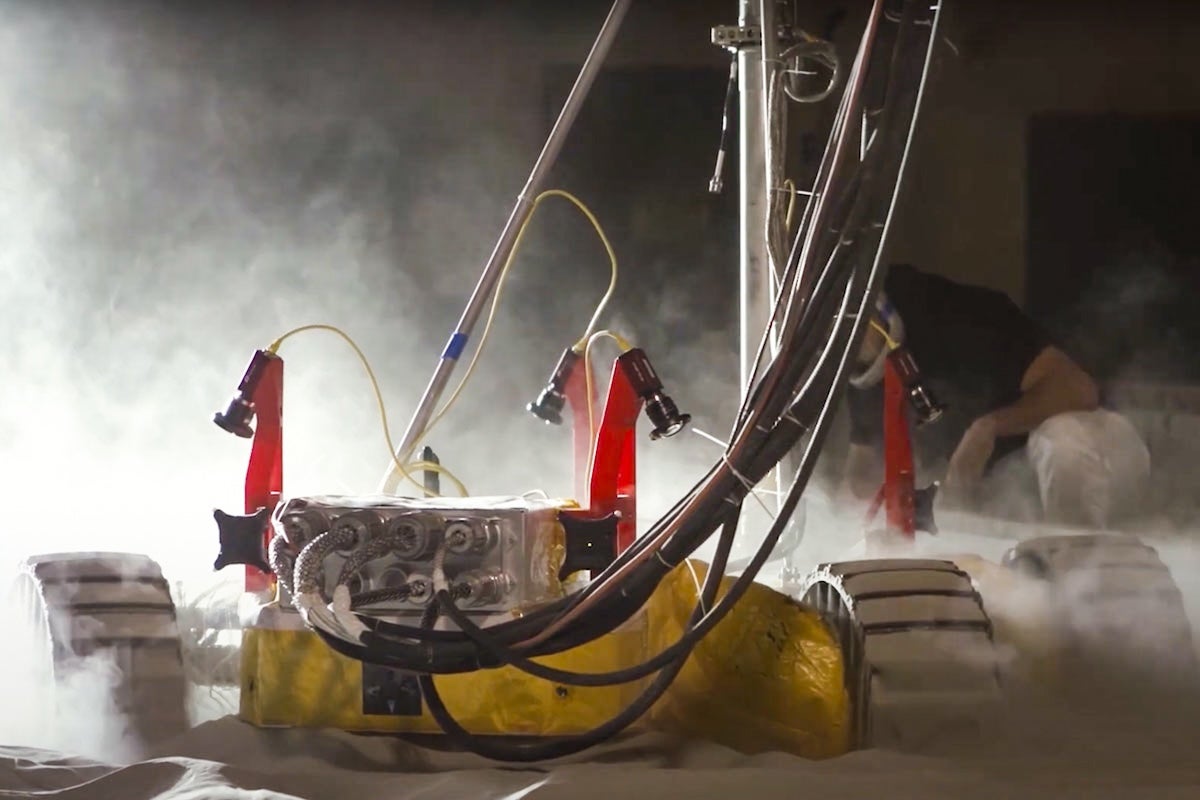More than 40 college teams from across the U.S. designing and building autonomous vehicles will soon find out if they are capable of navigating and conducting missions on a simulated lunar surface resembling the moon.
The robot rovers won’t be going into space — but they will face the next best challenge: to build a berm structure which would be useful to NASA’s Artemis program for navigating during lunar landings and launches, shading cryogenic propellant tank farms, providing radiation protection around a nuclear power plant and other mission-critical uses.
NASA created the Lunabotics Challenge in support of the Artemis program. UCF’s Florida Space Institute and its Exolith Lab will host the first round, sponsored by Caterpillar Inc., on May 11-14. The top 10 teams will advance to the demonstrations phase of the competition at the Kennedy Space Center May 15-17.
At UCF, students will be testing and showcasing their rovers in the same regolith bin that NASA, the European Space Agency and many companies use to evaluate and improve new equipment and technologies before launching them into space. Leaders in key industries that are important to Florida’s and the region’s workforce will serve as judges.
“Lunabotics gives students from throughout the United States an unrivaled opportunity to apply their knowledge of robotics and space to NASA’s design and construction processes,” says Winston Schoenfeld, UCF interim vice president for research. “The future of our space and many other high-tech industries depends on preparing a talented workforce that can innovate and work in highly collaborative team environments.”
Each team of college students has spent months designing and building a robot rover to NASA specifications that, during this challenge, will autonomously navigate a lunar-simulated arena and excavate regolith. They will compete two teams at a time per round, being given a set amount of time to collect regolith from the construction zone and dump it into a berm zone. Teams will be judged on a variety of factors, chiefly, the size of the berm they are able to build up in the regolith material with the rover.
The top 10 teams then travel to Kennedy Space Center for the culminating event, to demonstrate the operation of their functional tele-operated or autonomous robot to complete the lunar construction tasks. Students benefit from participating and having their work evaluated by NASA and private sector engineers, technicians and educators. NASA benefits by assessing student designs and data the same way it does for its own designs, encouraging innovation in student designs and identifying clever solutions to the many challenges inherent in future Artemis missions.
“NASA’s Artemis program is our plan to return humanity to the surface of the moon in a way that is sustainable over the long term. And the task of robotically building berm structures will be important for preparation and support of crewed lunar missions. These competing teams are not only building critical engineering skills that will assist their future careers, but they are literally helping NASA prepare for our future Artemis missions,” says NASA Software Developer & In-Situ Resource Specialization (ISRU) Researcher Kurt Leucht.
Founded to help fuel talent for the nearby space industry, UCF continues to build its reputation as SpaceU. NASA, with more than 50 years of research support from UCF, has advanced its Artemis program with the goal of establishing a sustainable human presence on the moon and preparing for missions to Mars. Prominent UCF space researchers are actively engaged in multiple collaborations with NASA — particularly within the Artemis program — and 29% of Kennedy Space Center employees are UCF alums.
“Students are taking on a challenge that also faces all of our top space agencies and companies — how can we design and build an autonomous vehicle that can reliably perform tasks on the surface of the moon?” says Julie Brisset, interim director of UCF’s Florida Space Institute. “The hands-on experience is invaluable for students and will help set them up for success on their campuses and in their future careers.”
Soil simulants used in the Lunabotics Challenge at UCF are created from crushed minerals. Once produced by UCF’s Exolith Lab, this regolith is now manufactured by a successful spinoff company, Space Resource Technologies. Other sponsors include Allen & Company, Lunar Outpost, Riegl USA and Venturi Astrolab.

As for the UCF Team, comprised of nine mechanical engineering and computer science students, learning how to work together as a team was as worthwhile an output as the lunar robot itself.
“Our ‘move fast and break things’ mindset has led to lots of creativity flowing to solve problems that came up with the design,” says Lee Marshall, who serves as team lead for UCF.
Their biggest challenge was creating a custom mechanical solution from scratch for the controls, according to Marshall. For the robot rover, materials came from 3D printers, an Xbox Connect being used as a camera and depth sensor, and other materials found in the Robotics Club lab.
“From observing the team, you can see their dedication, innate drive and determination to make it through the qualifying event,” says Crystal Maraj, faculty advisor for the UCF Robotics Club and an assistant professor with the Institute for Simulation and Training. “It takes a lot of time and effort, and I applaud these students for their success to iterate the design and utility of the robot for competition.”
Members of the public will be able to watch the competition rounds of the Lunabotics Challenge on the Florida Space Institute’s YouTube Channel. The Lunabotics live broadcast page can be accessed here.




